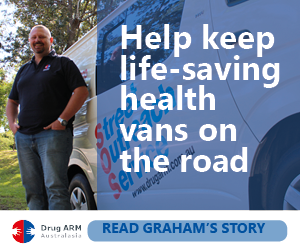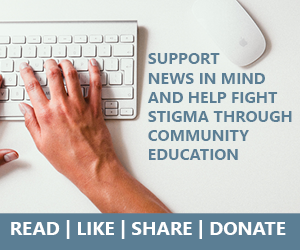Megan* can pinpoint the exact moment she knew she could not take it anymore. It was late afternoon on a perfect Sydney day and the mother-of-three was racing her eldest daughter to the emergency department of Westmead Hospital. The medical staff knew 14-year-old Jennie* by name. She’d been in and out of emergency for two years and admitted to the psychiatric unit three times. The nurses joked about getting Megan an official hospital ID pass. Except this time – like all the other times – it was no laughing matter.
Jennie had complex mental health issues – major depression, self-harm, anxiety, an eating disorder. Megan recognised the first signs when Jennie was just eight or nine. Over the years, Megan tried everything. In Year Six, she moved her daughter to a more supportive private school. Jennie saw a psychologist once a week and was under the care of both psychiatric and adolescent medicine teams at Sydney’s Westmead Hospital. Megan sought a second opinion at the Black Dog Institute. She called every community health service, but they said her daughter was too severe to access their services.
For a time, Megan even sent her daughter to live with her parents. “When your child acts like this, you wonder what the trigger is,” says Megan. “When the doctors can’t find anything, you blame yourself.”
But the cutting, which began when Jennie was 11 and was being bullied by the “popular girls” at school, grew worse. On that morning, Megan found 11 sharps – scissors, blades, knives, whatever Jennie could get her hands on – in her daughter’s bedroom even though Megan cleared it every day. Desperate to harm herself, Jennie had broken into the garage where all the household blades were locked up in a toolbox.
When Megan tried to stop her daughter, Jennie turned on her. She locked her mother in the garage, then raged at her siblings. Megan listened helplessly as Jennie screamed and hit out at her 12-year-old sister and seven-year-old brother.
“For the first time it dawned on me how dangerous she could be with a sharp,” says Megan, an articulate and intelligent woman from Sydney’s Blue Mountains, about an hour drive from the CBD. “It hit me like a tonne of bricks. I realised I had to protect my other two children.”
At the hospital, Megan told doctors she couldn’t do it anymore. She waited while Jennie’s deep wound – inflicted with another hidden blade – was treated. Then she delivered her message. She would not be taking Jennie home. She was handing her daughter over to be placed in the temporary care of the state.
“I said, ‘Don’t tell me she’s bandaged up and ready to go,’” recalls Megan. “‘This is it. I’m not taking her home. And I don’t want to hear anymore.’”
Unfortunately Megan’s story is not a one-off. The sheer number of young people struggling with mental illness in Australia is staggering. One in four people aged under 25 has a mental illness and this year, for the first time ever, suicide was reported as the leading cause of death in children aged five to 17. Among 15 to 24 year olds, twice as many die of suicide than in car accidents.*
There is no shortage of parents lining up to tell their stories. Or medical professionals speaking out about their concerns. They want more funding and better services, fast. There are simply not enough health workers to go around, and not enough resources to train more staff. The system, they say, is in crisis.
In April, the National Mental Health Commission’s review recommended an urgent overhaul. The report was damning, labelling the system as “ad hoc”, “fragmented” and “hit and miss”, with duplication in some areas and scant services in others. Getting the right treatment was based on “luck”.
The report’s finding was nothing new to parents. They tell of being unable to access child psychiatrists in regional areas; of children held sedated in adult psychiatric wards; of children being shunted on to medication without a word about behaviour management; of children suiciding after release from hospital; and of suicidal children being released into their parents’ care without a plan for ongoing treatment. Families are collateral damage. Careers stall, marriages collapse. Siblings move away to escape the drama.
One month before crisis point was hit with Jennie, a meeting was held between the hospital, the department of family services and Jennie’s school. Two hospital department heads attended, as well as Jennie’s psychologist and psychiatrist. They all warned that Jennie’s family was in crisis. At the end of the meeting, department staff said there was nothing they could do. Jennie, they argued, was well cared for, which technically meant, “Jennie was not a child in danger,” Megan recalls them saying. “They only care for children in danger.”
It took Megan’s ultimatum for the department to step in. Within days, Jennie was in a residential house with a dedicated mental health team caring for her around the clock. The department’s aim is to keep Jennie safe, then transition her back home once she’s stable. It takes six staff to do what Megan has been doing virtually alone, for years. She stands by her decision to relinquish her daughter’s care in order to get help.
“I was trying to save my daughter,” she says, choked with grief. “But when I asked for help I was turned away. I thought, the system is broken, but the system has to be there for my daughter. I’ve given everything and I can’t give anything more.”
There’s no doubt the system is on its knees. In juvenile mental health, early intervention is key. Yet a whole generation falls between the cracks. Dr Nick Kowalenko, chair of the faculty of child and adolescent psychiatry at The Royal Australian & New Zealand College of Psychiatrists, points to the numbers as proof. Around 13 per cent of all health problems stem from mental health disorders. Yet only five per cent of the health budget is allocated to mental health. Young people make up one quarter of the population. Yet less than 10 per cent of the mental health budget is spent on children.
“We should be getting the kind of funded base that goes to children’s cancer,” says Dr Kowalenko. Professor Ian Hickie, an expert in depression who sits on the National Mental Health Commission, echoes these sentiments, arguing the area is desperately underfunded. In 2012–2013, Australia spent $10 billion on mental health and suicide prevention. It’s a drop in the ocean compared to the mental health burden – an estimated $60 billion each year, according to the OECD.
“We wouldn’t half treat cancer, we wouldn’t grossly undertreat diabetes,” says Professor Hickie. “Yet we grossly undertreat mental health in young people.”
Funding is paramount, but not the only answer. Dr Kowalenko points to other challenges, such as a misunderstanding of child mental health among GPs and paediatricians, and adolescents who refuse treatment because they’re testing the boundaries of their autonomy.
“Stigma also gets in the way in the system,” adds Dr Kowalenko. “The system is not good on continuity of care and that requires real persistence and patience on the part of parents and their children, which is terribly hard.”
The federal government’s frontline response to youth mental health is the Headspace initiative. With more than 80 centres around the country, the initiative aims to provide a highly accessible, youth-friendly service hub. Each centre has a team of doctors, counsellors, youth workers and psychologists who work with 12 to 25 year olds, all under the same roof. The model aims to provide a “wraparound” service where a suite of health workers come to the person, in a unified and coordinated way.
But recently the National Mental Health review criticised this “one size fits all” model. Mental health expert Professor John Mendoza says Headspace centres receive a lion’s share of funding, yet see only 10 per cent of the one million Australians who are young and unwell.
For Headspace chief executive Chris Tanti, the bad press is counterproductive. He says Headspace has undergone two independent evaluations. The second report, looking at Headspace operations, is due to be handed to the government soon. The organisation is currently rolling out an extra 15 centres in order to increase its reach to children in need.
“For parents, its hard to know where to go,” agrees Tanti. “When you see a problem with your child, it’s hard to know whether it’s actually a problem or something that will pass. But things left untreated get worse. Most families have a fairly high threshold, then things get out of control.”
While Headspace is focused on early intervention, says Tanti, many young people still end up in the hospital system first because families seek treatment only when they reach a crisis point.
He believes the critical gap is in child mental health. The Royal Australian & New Zealand College of Psychiatrists estimates at least one child in everyprimary school classroom has childhood depression. But Tanti maintains there are too few child psychiatrists and most work in the private sector.
“There isn’t a system for addressing mental health in under 12s,’’ says Tanti. “Yet child psychiatrists recognise most of the mental illness they encounter in adolescents first presents while children are still at primary school.
“If we get a 10 year old [at Head-space], we say, ‘Let’s see them, let’s not turn anyone away.’ But it’s a different speciality and early intervention really requires a child psychiatrist, and then parents must pay for a private service.”
The family of 18-year-old Natalia Yandell were all too willing to go private. Eight years ago, Natalia was a bright primary schooler, chosen to represent Australia at a nanotechnology competition in Atlanta in the US.
By 2011, she had more than 300 cuts on her arms, legs, shoulders and torso. At the local child and mental health service in Cairns, Natalia told doctors about the darkness inside that made her want to die. The service turned her away, saying she was “not critical” enough. They referred her to group therapy, but she was too young – 14 instead of the required 16.
A private psychologist, which her mother scrambled together the money to pay for, threw up her hands, saying the case was “outside her field of expertise”. There was no private child psychiatrist working independently in the local area.
Four months later, Natalia took an overdose of painkillers. She was 15. It was the beginning of an horrific merry-go-round of hospital admissions and psychiatric wards, including adult psychiatric wards where Natalia was sedated without psychological treatment.
“We tried to get early intervention, but it wasn’t available,” says her mother, Margaret, a community outreach worker who had thought she “knew” the system. “You feel so isolated, and you think you’re to blame, and that your child is ruined for life. But the reality is it is happening far more than anyone imagines.”
It’s now been 100 days since Natalia last cut. She is seeing a therapist she trusts and has developed ways of coping. She hopes to eventually return to school. But managing her mental health will be a lifelong journey.
For Margaret Yandell, reflecting on the past four years is distressing. She doesn’t know what she could have done differently. She still doesn’t say her daughter is well, because she never knows. And she worries about the other parents struggling to cope, about the thousands of teenagers sitting alone in their bedrooms overwhelmed with pain.
“There are a lot of people dealing with terrifying things and they don’t know what to do,” she says. “Neither does the system.”
Professor Ian Hickie says the National Mental Health review has a road map to fix the system. It calls for $1 billion allocated to hospitals to be channelled into community health programs from 2017, as well as a boost to research and online technologies such as e-mental health clinics.
But the day after the report was released, federal health minister Sussan Ley rejected the key $1 billion recommendation and referred the report to an expert mental health reference group. The group will develop strategies to address the recommendations in the report.
Professor Mendoza is critical. “If the government is about efficiency, then it should simply heed the directions that are in the national review,” he says.
Professor Hickie remains optimistic. “It’s an action document. If it’s not this minister who picks it up, it will be the next one,” he says. “Community support is very strong and I don’t think a government will get away with no action.”
This article first appeared on ‘Yahoo!7’ on 31 July 2015.
























Melissa
This is so true. My youngest daughter has been verbally abused at school since grade 5, right down to 3 boys telling her to “kill herself” in that year. To her first year in high school where bullying has reigned supreme in her life again, both physically and via social media. To the point she felt cutting herself the only option left. I however happened to be one of the lucky parents in some retrospect as we have been lucky in having a wonderful GP who has organized her first psychologist when the bullying happened, sadly due to her own personal issues she has to leave where she practiced for an indefinate period. Right down to a eagle eyed teacher who spotted the cuts on my daughters ar, in class and sent her straight to the well being manager who in turn organized outreach and offers my daughter an open door. When she feels she is not understood or wanted. And i know shes not alone in this journey. In fact many children are screaming for help and there’s no one there to listen, and that is sad.